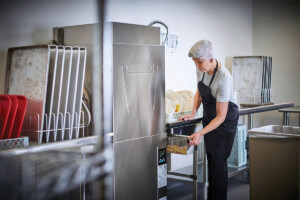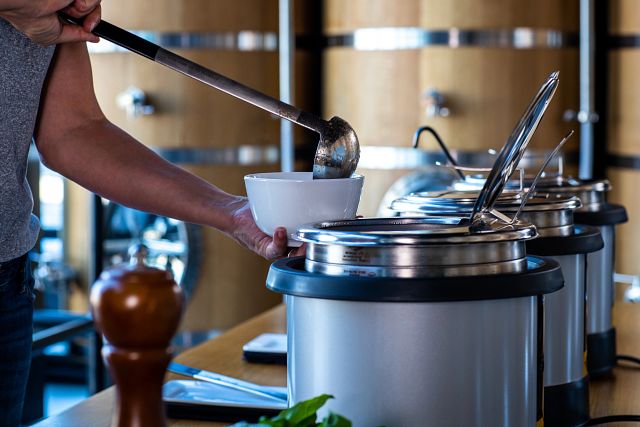In or Out: What To Know About Ventless Equipment
Experts share ideal applications for ventless equipment, plus a few limits to note.

Manufacturers continue to grow their ventless equipment offerings, delivering a world of possibilities to operators. Most recently, the category expanded to include an open canopy hood that can accommodate high-volume frying and protein cooking at the same time. It also now includes an oven with four cooking chambers, using convection or impingement, in one footprint. Operators looking to save on construction costs and maintenance of a traditional exhaust hood may wonder if ventless equipment makes sense.
“Ventless technology has been around a long time and if it was just an easy way to get rid of your exhaust hood, everybody would be doing it,” says Richard Young, director of Frontier Energy, which operates the Food Service Technology Center. “But everybody doesn’t do it because it’s not meant to be a blanket replacement for exhaust hoods in regular kitchens.” It’s a specialized technology for certain applications.
Today, ventless equipment includes everything from light-duty countertop units like high-speed ovens to ventless hood systems, aka recirculating hoods. There also are ventless combi ovens, steamers, display cooking stations, dishmachines and specialty equipment, like countertop fryers. Operators considering the technology will want to note in what applications it excels, what to keep in mind when specifying it and what’s coming up next.

Ventless dishmachines capture steam before it escapes, making for a more comfortable dishroom. This model includes a scrap basket to easily remove waste between washes. Courtesy of Hobart.
Where It Works
Foodservice design consultants rely on ventless equipment when they can’t use a traditional exhaust hood; it’s another tool in their toolbox.
“Typically it has to do with the architecture, like if it’s a renovation and we have limits on adding exhaust hoods or it’s a tall atrium, which happens on some of our corporate projects,” says Tarah Schroeder, vice president of Ricca Design Studios, who spoke about ventless at FER’s most recent Multiunit Foodservice Equipment Symposium (see “6 Tips” below). “A coffee shop/cafe is a great example of where just a few pieces can bring in additional revenue by expanding a menu.”
And those pieces often come with extra perks beyond ventless. “High-speed ovens have multifunction capabilities; they can become a panini press just by using a plate accessory,” says Jamison Day, senior project manager at Cini-Little Int’l. “Operators can program recipes into the ovens and all an employee has to do is hit a button to cook. There’s no training involved.”
On large-scale projects, such as stadiums, Ryan Rongo, vice president of design, and Peg Galie, senior associate, both with S2O Consultants, often rely on ventless equipment.
“We just opened the Superdome, which is an existing facility with a lot of renovation work on the concessions,” Rongo says. “Adding exhaust hoods wasn’t feasible because of the existing infrastructure so ventless equipment was used to help supplement that need for cooking.” An example might include a concession stand tucked underneath a seating area.
At Climate Pledge Arena, Galie says, the design team relied on ventless griddles because they couldn’t touch the historic roof. “We couldn’t use black iron so we basically had them in concessions everywhere. They became a show cooking piece,” she says.

Ventless multi-cook ovens provide simple recipe programming so employees can cook with the touch of a button. Courtesy of Alto-
Shaam.
Good To Know
All of this to say, ventless equipment has its limits. To start, it’s all electric; it doesn’t filter the carbon monoxide gas-powered equipment puts out. And with ventless hoods, there is usually a limit to how much wattage operators can place under them. A few other considerations include the following:
Heat and moisture stay. Ventless systems capture grease, not heat. And with Cal/OSHA’s recently passed indoor heat requirements, and a proposed rule in July by OSHA at the federal level, keeping kitchens below a certain temperature becomes even more critical. Figure the additional heat into the design process.
“If the heat has to be contained in the building, my suggestion is to go with the most efficient equipment possible so you get the most cooking done with the least amount of energy,” Young says. “Use combination ovens and tilting skillets and stay away from griddles, ranges and broilers.” And work with the engineers to make sure there is enough air conditioning in the space.
On the flipside, ventless dishmachines, a rapidly expanding category, remove heat from dishrooms, making them more comfortable. Also called heat recovery dishmachines, the units capture steam before it escapes and use it to heat water for the next cycle. Instant rebates are available on the dishmachines as well as other ventless equipment, Young says, which help offset the higher purchase price.
Watch for odors. Ventless systems don’t typically filter odors either. But that’s changing, says Dick Eisenbarth, president emeritus at Cini-Little and a judge for the National Restaurant Show’s Kitchen Innovations Awards program.
“It used to be you could always tell when there was ventless cooking equipment because there was just a stale smell in the space,” he says. “Now they’re using ozone to get rid of the odor.” In the example of the open canopy hood, the system leverages the use of ozone and a wet scrubber filter to capture and obliterate fats, oils and grease, returning clean air into the space.
Know the codes. There are codes related to ventless equipment and it helps to have them handy when the fire marshal arrives. Schroeder points to IMC 507, covering commercial kitchen exhaust hoods, which has two exceptions related to ventless technologies—UL 710B and UL KNLZ. Another good one to know is EPA 202, she says, which is the test method used to exempt cooking equipment from having an exhaust system.
Rongo adds that certain jurisdictions have limits on the number of ventless pieces an operator can put into a space. “New York and California both have limitations on how many pieces you can have in a single area,” he says. “There also are limitations from the manufacturers on how many pieces you can put next to each other.”
Factor in maintenance. Ask manufacturers what filters need to get replaced, how often and what’s the cost. While some filters are washable, others, like charcoal filters, are disposable. Figure in that ongoing cost.
Take care when cleaning ventless equipment, too. “You can’t just dump a bunch of water on it; you’ll soak your filters,” Galie says. “In the larger venues where volunteers might be working, we always have to make sure that there are people there with them, helping them understand what can and cannot be done from a cleaning standpoint.”

Filters on ventless cooking equipment, like combi ovens with recirculating hoods, require maintenance. If they’re disposable, ask manufacturers how often they need replacing and the cost. Courtesy of RATIONAL.
On the Horizon
Even with these limits, ventless equipment offers operators options when they need all the help they can get.
“We’re putting foodservice in all kinds of unexpected places, which means we need a lot more flexibility and that’s why ventless is so relevant right now,” Young says. “It allows you to go into places where you might not be able to put in an exhaust hood and add menu items at a time when the industry is suffering, having to evolve and thinking, ‘How do we keep making money?’”
Coming up, consultants predict the category will grow in a few ways, including ventless hoods that handle more equipment and an increase in reusable filters to reduce ongoing maintenance costs. Operators also can expect a wider use of modular cooking stations and specialty equipment.
For those operators who want to learn more about ventless equipment, Eisenbarth says, go check it out. “Many of these manufacturers have created training centers so end-users can use the equipment and test their recipes,” he says. Certain rep firms also have test kitchens available.
6 Tips
Operators considering ventless technologies will want to note the following tips:
- Think about whether it’s the best solution for the location
- Consider the menu and production capacity needed
- Understand the local landscape
- Choose the right equipment
- Plan for heat rejection
- Be ready to educate officials
Source: Tarah Schroeder of Ricca Design Studios during her presentation “Real Life Experiences Designing Ventless Kitchens” at MUFES 2024
More Resources
To learn more about the heat illness regulations, rebates and how to optimize ventilation, Richard Young of Frontier Energy points to the following websites:
- Cal/OSHA Heat Illness Prevention Guidance and Resources: dir.ca.gov/dosh/heatillnessinfo.html
- OSHA Heat Injury and Illness Prevention in Outdoor and Indoor Work Settings Rulemaking: osha.gov/heat-exposure/rulemaking
- California Foodservice Instant Rebates: caenergywise.com/instant-rebates/
- California Energy Wise’s “Creating an Effective, Code-Compliant, Commercial Kitchen Ventilation (CKV) System in Vented and Ventless Applications” recording: caenergywise.com/seminars/previous-seminars/
RELATED CONTENT
- Advertisement -
- Advertisement -
- Advertisement -
TRENDING NOW
- Advertisement -
- Advertisement -
- Advertisement -


